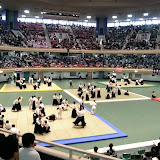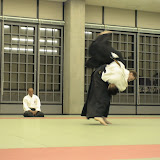“Never look down to test the ground before taking your next step. Only he who keeps his eyes fixed on the far horizon will find the right road.”- Dag Hammarskjold, the 2nd UN Secretary-General
I’m over thinking, and how it gets in the way of practice, no amount of thinking about a particular technique will help me become better at it. It is the old paralysis through analysis that that turns a freely executed technique, warts and all, in to a hesitant and harmless exercise.
Yesterday morning we practiced more katatedori kokyunage (wrist hold breath throw : 片手通り呼吸投げ) and tsuki kokyunage (knife strike breath throw : 突き呼吸投げ), and the sensei drew attention to the fact that a technique executed by a white belt is different not only in appearance to the same technique done by a black belt. A white belt is concerned with form and peforming so as not to draw to much attention to their weaknesses. A black belt is concerned with meeting with and directing the opponents energy in accordance with their strengths.
Putting yourself in an advantageous position against an opponent requires an intimate knowledge of where that opponent is in time and space, not just an awareness of your own technique. All too often once the opponent has taken a hold of your wrist it is easy to forget they are there, hoping that a well executed technique will have the desired effect. Entering and disrupting the opponents balance requires that through that contact point, be it the wrist, the shoulder or the waist, you feel the opponents power.
There are usually two erroneous responses to recieving an opponents force. One is to retreat from it too quickly leaving a gap into which the opponent follows (Newtons 1st Law of Motion). The other is to bump up against it, or push it away, which normally results in a equally strong response in opposition (Newtons 3rd Law of Motion). These two principles, pondered upon by Aristotle and Galileo, and enumerated by Newton, are just as important when considering the execution of
Aikido techniques.
The middle ground is to direct the opponents mass moving with a certain acceleration through application of a force (Newtons 2nd Law of Motion). When we combine our technique effectively with the assault of the opponent we acheive a much greater effect than if we were acting alone.
I get the greatest impression of this when we do zagi kokyuhou
(seated breath technique : 座ぎ呼吸法), the harder you push against the opponent the less likely they are to budge, letting the opponent in results in almost immediate defeat. Finding the rythm of your own breath and positively feeling the opponents strength allows you to find a small moment, or opening, that allows you to take control of both of your centres.
Tonights practice is sure to be more preparation for Tokyo, and perhaps another black belt grading. I will take care to be fully aware of not only my own technique but also the strength of my opponent.





3 comments:
Thanks for the link. I will add your blog to my links.
Thank you, I really enjoy your blog so much so that it inspired me to write this one.
"paralysis through analysis" - I like that phrase, suffering from this affliction as I do :-)
The other day the one other student who was practicing with me was getting stuck in "too much thinking" as was I, and Sensei had us close our eyes to do the move (katatedori kotegaeshi I think - names still stump me) and it was FABULOUS!
With my eyes closed I didn't get wrapped up in which direction I was supposed to go and it was lovely, realizing that my muscles knew what to do. It just worked. Afterward, I thought maybe I should just close my eyes through my next test :-)
jr. fiction, I really enjoy reading your posts though I haven't commented before and am playing catch-up due to work being busy lately. Your thoughtfulness (distinct from thinking-too-much) is apparent and helps illuminate, for me, some of my experience as an Aikido beginner.
Thank you.
Post a Comment